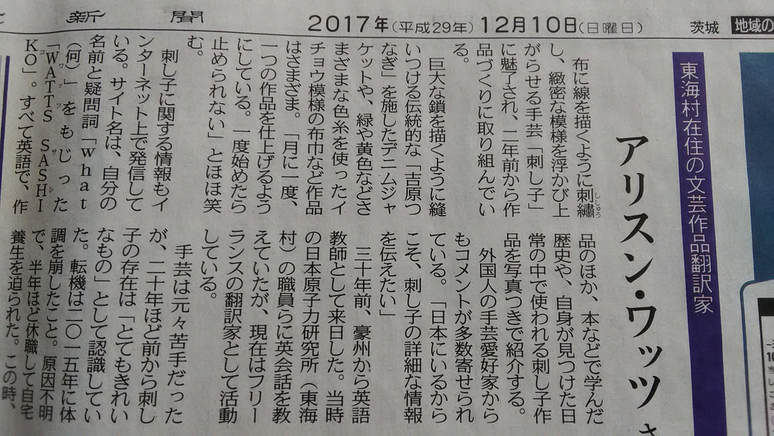|
This a translation of an article written by a journalist from the Tokyo Shimbun newspaper ( December 10th, 2017). It felt very strange to translate myself, but at least I could easily check the quotes with the source! Alison Watts (54). Literary Translator and Resident of Tokai-mura Alison Watts became fascinated by intricate sashiko patterns stitched on fabric and began making her own work two years ago. She makes about one piece a month, and has made items such as a denim jacket stitched with Yoshiwara tsunagi (large entwined chains), and a decorative cloth stitched in yellow and green gingko leaves. “Once I start I can’t stop” she says with a smile. Alison also writes about sashiko on the internet. On her Watts Sashiko website she introduces pieces she’s made, facts about sashiko she’s learned from Japanese books, reviews of books, as well as sashiko pieces she has found being used in daily life along with photos. Overseas fans of sashiko leave comments on her site. “I want to make the most of living in Japan and my language skills to provide the kind of information and detail about sashiko that is not available elsewhere,” she says. Alison came to Japan from Australia thirty years as an English teacher. She taught staff at the Japan Nuclear Research Institute (in Tokai-mura) but now works as a freelance Japanese to English translator. She became aware of the beauty of sashiko about twenty years ago, and although not very skilful at sewing or craftwork herself, bought some kits to try it. A turning point came, however, in 2015 when she became ill and couldn’t work as a translator for six months. While resting at home she began doing sashiko again and became completely absorbed by it, even starting to make her own pieces instead of using kits. “It was so soothing, and satisfying. I found that even a clumsy sewer like myself could still make things easily and enjoy it,” she recalls.
Alison turned the experience of being ill into an opportunity to change her life. She began pursuing her passion for sashiko when she recovered, by joining a sashiko group in the town, and starting up a website and blog. This month she opened an online shop on her website, which is selling sashiko kits sourced from a Nagoya-based craft company. The kits contain English instructions she translated herself. “Sashiko is growing in popularity as it becomes more and more widely known overseas,” says Alison who senses a need for more literature in English, as there is very little available. “I think it’s because sashiko is beautiful and easy to do. It’s a craft that anybody can enjoy. You don’t need to be an expert sewer,” she says. Alison Watts. Born in South Australia, October 1963. A literary translator by trade, she has translated Durian Sukegawa’s novel An (English title: Sweet Bean Paste). She also produces poetry and music concerts, and in February produced a concert in Tokai-mura to mark the sixth anniversary of the 2011 disasters. The concert featured Durian Sukegawa’s performance of “A New Road to the Far North,” the record of a journey he undertook six years ago by bicycle, travelling in the footsteps of poet Matsuo Basho and measuring radiation along the way in disaster-ravaged areas.
2 Comments
janine beichman
12/20/2017 11:57:15 am
I enjoyed reading this, Alison, and am looking forward to seeing more on your website.
Reply
Alison
12/20/2017 05:11:32 pm
I'm glad to hear it, Janine. Thank you. I'll try to keep it coming!
Reply
Leave a Reply. |
Watts SashikoI love sashiko. I love its simplicity and complexity, I love looking at it, doing it, reading about it, and talking about it. Archives
September 2022
Categories
All
Sign up for the newsletter:
|




 RSS Feed
RSS Feed



